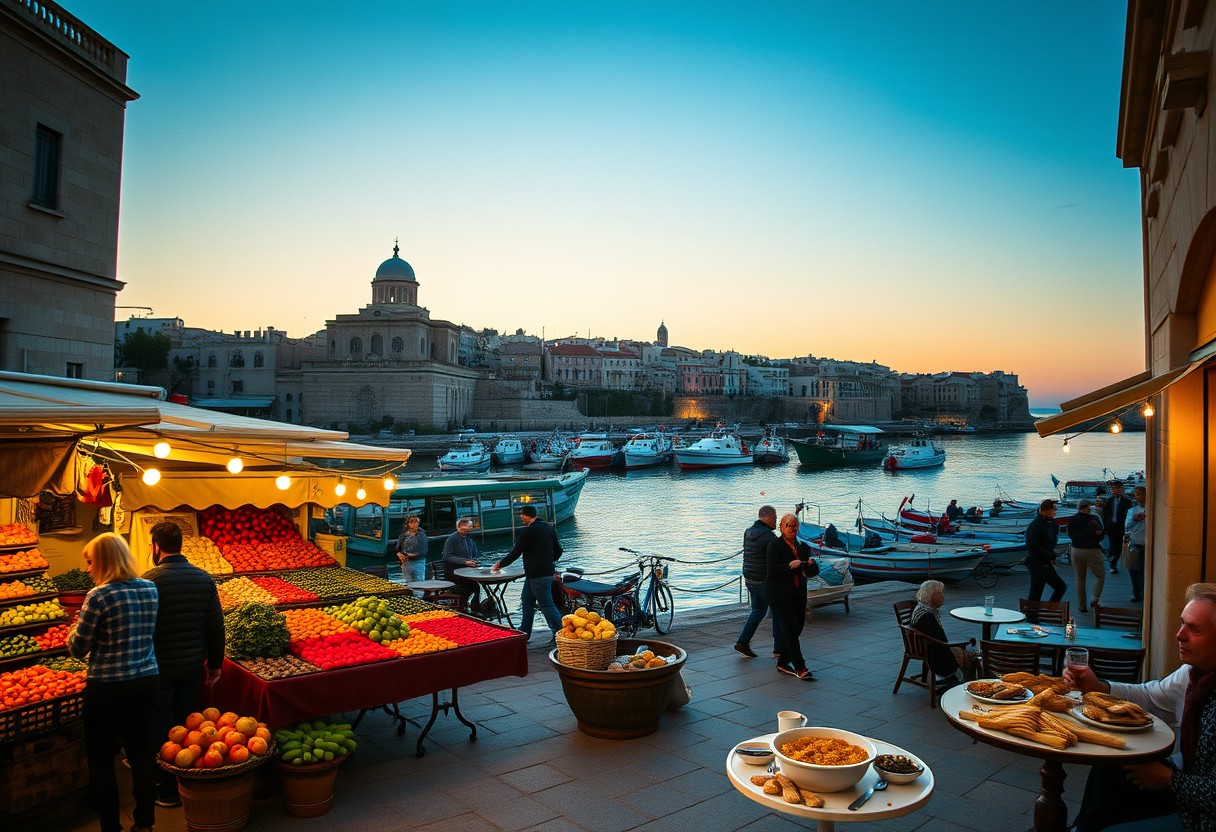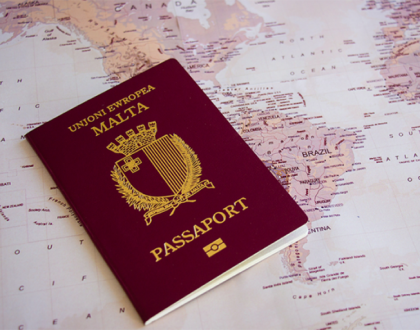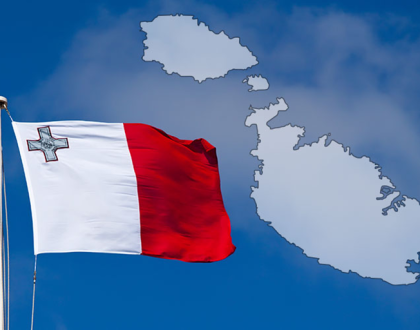A Foodie’s Guide to Malta

There's no better time to explore the culinary treasures of Malta than in September and October, when the island's rich harvest season brings a vibrant array of local dishes and flavors to your table. As you navigate through bustling markets and cozy restaurants, you'll discover seasonal delights and traditional recipes that showcase Malta's unique blend of Mediterranean influences. From fresh seafood to artisanal cheeses, this guide will help you uncover the best food experiences to savor during this picturesque time of year.
Understanding Maltese Cuisine
Before you initiate on your culinary journey through Malta, it's imperative to understand the rich tapestry of flavors and traditions that define its cuisine. Influenced by its geographical location at the crossroads of Europe and North Africa, Maltese food combines Mediterranean elements with a unique local twist. You will find that meals are often characterized by hearty ingredients, aromatic herbs, and a celebration of fresh seafood, which altogether provide an authentic and vibrant experience of Maltese life.
Types of Traditional Dishes
With a deep-rooted history, the traditional dishes of Malta are as diverse as the islands themselves. You might be tempted to explore the array of flavors found in the island's many classic offerings, which include the following:
| Dish | Description |
| Rabbit Stew (Fenkata) | A popular dish, slow-cooked with wine, garlic, and herbs. |
| Bragioli | Beef olives stuffed with a flavorful mixture of breadcrumbs and spices. |
| Pastizzi | Puff pastry filled with ricotta cheese or peas, often enjoyed as a snack. |
| Stuffed Caponata | Vegetables, typically eggplant, stuffed with a savory mix. |
| Fish Soup (Aljotta) | A fragrant soup made from fresh fish and flavored with herbs. |
The selection above serves as just a snapshot of the traditional Maltese dishes you can savor. Each of these recipes tells a story of Malta's heritage and reflects the rhythms of local life.
Popular Ingredients
Any stroll through the local markets will reveal the diverse ingredients that elevate Maltese cuisine. You will find an abundance of fresh produce, from tomatoes and olives to capers and citrus fruits. Freshly caught fish and seafood are staples here, along with rich, hearty meats like rabbit and pork. Maltese cuisine also leans heavily on the use of aromatic herbs, such as oregano and basil, along with spices like cumin and coriander that add warmth and depth to your dishes.
Understanding the significance of these ingredients is imperative to truly appreciate the authentic flavors of Maltese cooking. Local farmers and fishermen play a vital role in their vibrant markets, ensuring that you have access to fresh and high-quality products that represent the island's agricultural bounty.
Unique Cooking Techniques
To fully appreciate Maltese cuisine, you must also grasp the unique cooking techniques employed by local chefs. Traditional methods such as slow-cooking and roasting are commonly used to develop rich flavors, while fresh ingredients are often showcased in simple yet elegant presentations. You will also observe that communal cooking is significant, with many families coming together to prepare and enjoy meals, leading to the sharing of olive oil, bread, and local wines.
Unique to Malta are dishes prepared in a “tined” (or “tinid”) style, where meats and vegetables are cooked together in a sealed pot, creating a tender and aromatic final product. This technique is just one example of how Maltese culinary traditions have adapted and evolved over generations.
Unique to Malta is the rich culinary tradition that invites you to discover, enjoy, and share in the flavors of this beautiful island. Coming together with friends and family over a meal is more than just about sustenance—it's about connecting to Maltese culture and experiencing its rich history in every bite.
Best Time to Visit Malta for Foodies
Some might think that the culinary delights of Malta are available year-round, but timing can greatly enhance your gastronomic adventure. September and October are particularly favorable months for food lovers, as they not only usher in the harvest season but also bring a variety of local events dedicated to food and tradition. By planning your visit around this time, you can experience fresh, seasonal ingredients that celebrate the Mediterranean's bounty, making it easier to explore traditional Maltese recipes and contemporary cuisine alike.
Seasonal Factors
Little do many travelers know that Malta's rich culinary scene is strongly influenced by its seasons. During September and October, the islands transform with a vibrant array of freshly harvested fruits and vegetables. This is the perfect time to indulge in local specialties like caponata, a Sicilian-inspired dish, and fresh fish which are abundant as the fishing season ramps up. Additionally, you will find that many local eateries focus on promoting seasonal menus, highlighting the freshest produce and local meat, thereby offering you an authentic taste of Malta.
- Harvest season brings new flavors to the table.
- Restaurants focus on seasonal ingredients, enhancing culinary experiences.
- October is known for the grape harvest, perfect for wine tasting.
Knowing how to choose the right time to visit can allow you to maximize your foodie experience in Malta.
Weather Considerations
Time is also a crucial aspect for foodies visiting Malta in September and October, especially regarding the weather. The climate during these months tends to be pleasantly warm, with daytime temperatures averaging around 25 degrees Celsius (77 degrees Fahrenheit), creating an inviting atmosphere for outdoor dining. The evenings can be cooler, making it ideal for enjoying leisurely meals on terraces while savouring delicious Maltese wines under starlit skies. Such weather offers you the opportunity to embrace both al fresco dining and cozy indoor settings, depending on your preference.
Visit Malta during this period, and you can expect to revel in the delights of outdoor food markets and seaside eateries. The gentle breezes and cool nights set the perfect backdrop for enjoying the diverse array of local dishes, from pastizzi to rabbit stew, enhancing your overall experience.
Local Festivals and Events
Foodies will find that Malta comes alive in September and October, as numerous festivals highlight the island's rich culinary heritage. These local events often feature food stalls, cooking demonstrations, and tastings, allowing you to sample traditional dishes prepared by local chefs. One of the most notable festivals is the Malta International Food Festival, where you can delight in an array of cuisines from around the island. This is not only a chance to enjoy great food but also an opportunity to immerse yourself in Maltese culture through music, dance, and artisan crafts.
Moreover, October kick-starts the wine harvest season, resulting in veritable wine festivals that celebrate local vineyards and their exquisite offerings. You can join in the festivities and sample a selection of Maltese wines while enjoying food pairings, making this an irresistible aspect to your culinary journey.
Factors like the thriving harvest season and local celebrations create an ideal backdrop for your food adventure, allowing you to savour Maltese flavors while engaging with local culture. The combination of vibrant events and delicious cuisine makes September and October not just a good time, but the best time for you as a foodie seeking an unforgettable experience in Malta.
Recommended Food Tours and Experiences
Keep your taste buds tingling as you explore the culinary delights of Malta in September and October. This is the perfect time to launch on memorable food adventures that showcase the island's rich gastronomic heritage. Whether you're a seasoned foodie or just starting your culinary journey, Malta offers numerous guided experiences that let you savor and celebrate local flavors.
Guided Culinary Tours
Tours that take you through Malta's bustling markets, quaint villages, and rustic farms are a must for any food lover. You'll have the opportunity to meet local chefs and artisans, learning about traditional cooking methods and the significance of various ingredients. Engaging with passionate guides, you'll discover not just the tastes but the stories behind each dish, enhancing your overall appreciation of Maltese cuisine.
Many guided culinary tours also include tastings of local wines, cheeses, and sweets, allowing you to experience the full spectrum of Maltese flavors. Keep an eye out for tours that focus on unique themes like street food, family recipes, or even culinary history to enrich your understanding of this beautiful island's offerings.
Cooking Classes and Workshops
While exploring cooking classes and workshops, you'll find that many local chefs are keen to share their culinary secrets with you. These hands-on experiences not only teach you how to prepare traditional Maltese dishes but also offer you a chance to get to know the local culture and lifestyle. You can expect to learn about staple ingredients like fresh seafood, local herbs, and traditional spices while whipping up delightful meals that you can recreate back home.
Plus, participating in these classes often culminates in a communal meal where you can enjoy the fruits of your labor alongside fellow cooking enthusiasts. You'll not only take home new recipes but also lasting memories and perhaps a few new friends who share your love for food.
Wine Tasting Experiences
On your culinary journey through Malta, don't miss the opportunity to indulge in wine tasting experiences that showcase the island's unique viniculture. You can visit local wineries that produce a range of wines, from robust reds to crisp whites, often made from indigenous grape varieties. A skilled sommelier will guide you through each tasting, sharing insights into the winemaking process and the characteristics of each varietal, enhancing your appreciation for Maltese wines.
A well-curated wine tasting can also pair beautifully with local cheese, olives, and cured meats, making for a delightful culinary experience. This not only allows you to savor the wines but also introduces you to the perfect food pairings that elevate the tasting experience to new heights. Don't hesitate to ask questions during your tasting—you might just uncover a new favorite wine to bring home!
Dining Tips for Travelers
Now, as you prepare to immerse yourself in the culinary delights of Malta during September and October, it's important to arm yourself with some dining tips that will enhance your experience. Whether you're indulging in fresh seafood by the coast or exploring local markets for traditional pastries, being aware of a few key aspects of dining in Malta can ensure that your meals are as enjoyable as they are flavorful.
- Always check for local dining hours, as they can differ significantly from what you may be accustomed to.
- Make reservations when possible, especially at popular restaurants.
- Observe local customs when dining, such as how and when to tip.
- Don't hesitate to ask staff for recommendations—they're usually very knowledgeable about the menu.
- Be open to trying new dishes; Maltese cuisine has a lot to offer that you might not find elsewhere!
Perceiving the dining culture in Malta will not only enhance your culinary journey but also allow you to engage more meaningfully with the local community.
Reservations: When and How
You should definitely consider making reservations, especially in popular restaurants where tables can fill up quickly during the peak tourist season in September and October. Many locals also dine out during these months for special occasions, so it's wise to call ahead or book online to secure your spot. Checking a restaurant's website for their reservation policy can also save you from potential disappointment.
If you're unsure about how to make a reservation, it's as easy as calling the restaurant directly or using an online reservation platform. When making a booking, be clear about the number of guests and the time you would like, and don't forget to confirm your reservation on the day of your dining experience to avoid any mix-ups.
Navigating Menus and Local Customs
Reservations aside, navigating menus in Malta can be an adventure in itself. Due to the variety of influences on Maltese cuisine—from Italian to North African—you'll find a wide array of interesting dishes. Familiarize yourself with common Maltese terms and local specialties like “pastizzi” (savory pastries) or “rabbit stew,” which is a must-try.
Dining in Malta may also come with its own set of customs. For instance, it's customary to wait for the host or the oldest person at the table to begin eating before you dig in. As dining is a social affair, you'll often find families sharing plates or enjoying a long meal over conversation, so don't rush your experience.
Language Tips for Foodies
Language can be another barrier, but don't worry too much about mastering Maltese before your trip! While most locals speak English, learning a few key phrases can go a long way in enhancing your dining experience. Simple greetings and words of appreciation will earn you smiles and sometimes even a complimentary dish!
- “Grazzi” means thank you, and locals appreciate when you say it.
- “Kif int?” translates to how are you?—a friendly conversation starter.
- “Jien” means I; you'll find this helpful when sharing personal opinions about dishes.
- Practice ordering a drink in Maltese, like “Bżonn-il ilma, jekk jogħġbok” for “I need water, please.”
- Be patient and open when communicating; many locals are eager to help you navigate their menus.
Assume that a small effort can yield big rewards in local interactions.
Menus in Malta offer a mix of local and international dishes, so it's beneficial to familiarize yourself with some common terms and ingredients. You may find plenty of grilled octopus, goat cheese, and local wines on the menu, which are staples in Maltese cuisine.
- Look for “ħobż” (bread), which is often served in a variety of ways, including as a sandwich.
- “Arjoli” refers to a type of fish dish that is excellent in many local restaurants.
- Be mindful of vegetarian options; dishes may include local vegetables and legumes.
- “Torta” could indicate a sweet dessert, perfect for ending your meal on a high note.
- Inquisitive diners often ask about specials, which may allow you to taste the freshest offerings.
Assume that exploring menus with curiosity will lead to delightful discoveries.
Exploring Local Markets
Despite its small size, Malta is bursting with vibrant local markets that reflect the rich culinary culture of the islands. As you wander through these markets, you will encounter a myriad of fresh produce and artisanal products that provide a true taste of the Maltese way of life. From bustling farmers' markets to charming flea markets, each location promises a unique shopping experience where you can connect with local vendors and indulge in the region's best offerings.
Types of Markets: Fresh Produce and Artisanal Products
Fresh produce markets are a staple in Maltese towns, showcasing an array of seasonal fruits, vegetables, and herbs. Artisanal markets, on the other hand, focus on locally crafted goods such as honey, olive oil, cheeses, and baked goods, allowing you to savor the authentic flavors of the islands.
| Types of Market | Description |
| Farmers' Markets | Fresh fruits and vegetables sourced directly from local farms. |
| Artisan Markets | Handmade products including cheese, bread, and other delicacies. |
| Craft Markets | Local crafts and souvenirs made by Maltese artisans. |
| Flea Markets | Unique finds, second-hand goods, and antiques. |
Perceiving the local culture through its markets is a delightful adventure that enriches your foodie journey in Malta.
Shopping Tips for Visitors
Now, as you prepare to explore the markets, it's beneficial to keep a few shopping tips in mind to enhance your experience. Consider visiting in the morning when vendors are fully stocked and fresh goods are readily available. Moreover, take the time to engage with the local sellers; many of them are happy to share cooking tips or stories about their produce, making your shopping experience even more memorable.
- Bring cash, as not all vendors accept cards.
- Try to learn a few basic Maltese phrases; it often delights the vendors.
- Stay hydrated; markets can get hot and crowded.
- Be ready to bargain, especially in flea markets.
Thou will find that navigating the lively atmosphere of Malta's markets can be a delightful challenge that allows you to indulge in your foodie passions.
If you're eager to experience the full spectrum of what these markets have to offer, consider setting a specific day aside for just market hopping. From tiny stalls selling artisanal cheese to larger setups offering fresh fish and meats, you can create a route that ensures you don't miss any critical stops. Don't forget to explore specialty goods unique to Malta, such as Ġbejniet (cheeselets) and pastizzi (savory pastries).
- Wear comfortable shoes, as you'll likely do a lot of walking.
- Carry reusable bags for your purchases to reduce plastic waste.
- Observe busy stalls; they often signify the best products.
- Try samples, as vendors usually have tasting stations.
Thou will discover that blending in and exploring what each market offers is part of the fun, leading you to delicious finds and engaging conversations.
How to Make the Most of Your Market Experience
Now that you have a better understanding of the types of markets and tips for success, it's time to dive deeper into how to maximize your experience. Arrive early in the day to witness the markets at their liveliest, avoiding the afternoon rush when both vendors and products may dwindle. Take the time to savor your surroundings; enjoy the sights, sounds, and, of course, the tastes of local goodies as you stroll from stall to stall.
To truly immerse yourself in the local culture, consider joining a food tour that includes market visits. This way, you'll have the chance to enhance your market experience through knowledgeable guides who can provide insights into Maltese food and customs. They often introduce visitors to local delicacies that may not be readily visible to the casual shopper.
Pros and Cons of Eating Out in Malta
Once again, you will find that eating out in Malta offers a unique culinary experience. However, like any destination, there are both advantages and disadvantages to dining in local restaurants. It's important to weigh these factors to make the most out of your food adventures in this Mediterranean paradise.
| Pros | Cons |
|---|---|
| Diverse cuisine influenced by various cultures | Price points can be higher than expected |
| Fresh, locally sourced ingredients | Limited availability of certain food items in off-peak seasons |
| Seasonal specialties provide variety | Tourist areas may have inflated prices |
| Opportunity to try traditional Maltese dishes | Occasional inconsistent service levels |
| Many outdoor dining options with stunning views | Some popular spots require reservations |
Pros: Diversity and Freshness
Clearly, one of the standout features of dining out in Malta is the remarkable diversity of cuisine you'll encounter. The island's history of trade and occupation has imbued it with a blend of influences—from Italian and North African to British and Middle Eastern. This means that not only can you find your favorite local dishes like rabbit stew and pastizzi, but also enjoy a range of international flavors. Furthermore, many restaurants prioritize using fresh, locally sourced ingredients, ensuring that the dishes you taste are around the highest quality and embody the rich flavors of the Mediterranean.
Additionally, dining out enables you to explore seasonal specialties that change with the months. If you are visiting in September or October, you can take advantage of the grape harvest season by enjoying various wine pairings, and you might even stumble upon delightful menus that highlight seasonal ingredients. This diversity allows you to enjoy meals that are not only delicious but also reflective of the dynamic cultural landscape of Malta.
Cons: Price Points and Availability
If you're a budget-conscious traveler, be aware that eating out in Malta can sometimes hit your wallet harder than anticipated. While you can find a range of price points, a meal in a touristy area might be considerably more expensive, especially if you are drawn to high-rated restaurants. Additionally, during the off-peak months, certain food items may become less available, affecting your dining choices. You might find that specialty ingredients or dishes are not offered, limiting your options when it comes to trying out local delicacies.
One of the notable factors affecting the price of dining out is the tourist-centric inflation. While there are certainly affordable options, it requires some effort on your part to seek out local gems away from the main tourist trails. Reading reviews and doing some research can help you find places that deliver great value, but you must remain vigilant about where you choose to dine.
Pros of dining out in Malta are complemented by the drawback of variable pricing, which can take you by surprise if you're not well-informed. This dynamic means you can enjoy an extraordinary meal or walk away with a hefty bill, depending on your choices.
Cost Comparison: Dining Out vs. Home Cooking
Malta offers a variety of dining experiences, but it's important to assess how eating out compares to cooking at home. While cooking at home can save you money in the long run, you might miss out on the rich culinary experiences offered by local chefs. It's also worth considering that the cost of ingredients can fluctuate based on seasonality and availability, impacting your home cooking budget.
| Dining Out | Home Cooking |
|---|---|
| Higher initial investment per meal | Lower overall cost if you plan meals |
| Convenient and time-saving | Requires time for shopping and preparation |
| Access to unique flavors and local dishes | Control over ingredients and dietary preferences |
| Social experience with locals and travelers | Enjoyable family or friend gatherings at home |
| Inconsistent meal quality depending on the restaurant | Consistent quality based on your cooking skills |
Another aspect to keep in mind is that while dining out can be expensive, many restaurants offer lunch specials or early-bird deals that make eating out more affordable. Exploring these opportunities can enhance your experience without straining your budget too much. Ultimately, whether you eat out or cook at home, it's all about balancing quality, taste, and practicality during your visit to Malta.
Step-by-Step Guide: Crafting Your Meals at Home
All great culinary adventures begin at home, where the heart of Maltese cuisine can be experienced through your own hands. By following this step-by-step guide, you will be able to uncover the secrets of delicious Maltese dishes that will impress not only your palate but also your family and friends. You can transform your kitchen into a Maltese haven with just the right recipes, ingredients, and techniques.
| Step | Action |
|---|---|
| 1 | Gather your important Maltese recipes. |
| 2 | Sourcing key ingredients from local markets or specialty stores. |
| 3 | Utilize authentic cooking techniques to elevate your dishes. |
Essential Maltese Recipes
An important starting point for your culinary journey is to choose recipes that embody the rich flavors of Malta. Some must-try dishes include Rabbit Stew (Fenkata), the Maltese Pie (Pastizzi), and the hearty Bragioli. These recipes not only showcase the island's traditional fare but also emphasize the use of fresh local ingredients. By immersing yourself in these authentic dishes, you will gain a deeper understanding of Maltese culture and its delectable offerings.
As you craft your meals, be sure to incorporate local favorites such as capers, olives, and sun-dried tomatoes. Many of these ingredients are readily available and can elevate your dishes to new heights. Experimenting with different flavors and textures will allow you to create a unique representation of Maltese cuisine right in your own kitchen.
Ingredient Sourcing
While creating traditional dishes is important, sourcing your ingredients effectively is equally important. Visiting local farmers' markets is a great way to uncover the freshest produce and artisanal products. In Malta, you'll find a stunning array of vegetables, cheeses, and meats that can be directly sourced from local producers, ensuring the utmost quality and flavor.
Make an effort to find iconic Maltese specialties, such as gbejna (Maltese cheese) and regional wines, which play a key role in many traditional recipes. Your dishes will taste more authentic if you use locally sourced ingredients, so take the time to explore local shops and farmer's markets in your area.
Plus, engaging with local vendors or farmers can provide you with insights into the best seasonal products and how to prepare them. This not only enhances your culinary skills but also builds a connection with the food community, enriching your cooking experience further.
Cooking Techniques for Authentic Flavors
StepbyStep, mastering the cooking techniques necessary to create authentic Maltese dishes will transform your meals. For instance, slow-cooking rabbit in a rich tomato sauce is a traditional method that results in tender, flavorful meat that captures the essence of Maltese cuisine. Likewise, frying pastizzi until golden brown ensures that the pastry remains flaky and delicious. These techniques require patience and practice, but they are important for replicating authentic flavors at home.
Additionally, you may want to learn how to incorporate unique spices and herbs prevalent in Maltese cooking, such as mint, bay leaves, and fennel seeds. Understanding these nuances adds depth and character to your meals, making them truly memorable.
Guide your culinary experience by focusing on the essence of how each ingredient interacts with the others, and don't hesitate to adjust techniques based on your personal preferences. Experimentation in the kitchen can often lead to delightful discoveries that inspire your culinary journey into Maltese cuisine.
To wrap up
The vibrant culinary scene in Malta during September and October offers you a unique opportunity to indulge in local flavors and seasonal delicacies. As you explore the islands, you'll find that this time of year not only showcases the rich Maltese heritage but also allows you to savor fresh ingredients at their peak. From traditional dishes to modern interpretations, your experience will be enriched by the variety of food festivals and events that celebrate the locale's gastronomy. Don't forget to take advantage of the pleasant weather while dining al fresco, allowing you to enjoy the stunning views that Malta has to offer.
Your foodie adventure in Malta shouldn't be rushed; instead, take the time to appreciate the diverse range of offerings that each region presents. Embrace everything from street eats to fine dining, and be sure to engage with local chefs and food artisans who can provide you with insights into the culinary traditions that have shaped the islands. Whether your palate craves savory meat dishes, fresh seafood, or delectable desserts, Malta in September and October has a feast waiting for you. So gear up, bring your appetite, and get ready to discover a true culinary gem in the Mediterranean.
FAQs
What makes Maltese cuisine unique?
Maltese cuisine stands out due to its blend of Mediterranean and North African influences. It features fresh, seasonal ingredients like seafood, rabbit, and aromatic herbs, all prepared using traditional methods such as slow-cooking and roasting. This creates hearty, flavorful dishes that reflect Malta’s rich cultural heritage.
When is the best time to visit Malta for a food-focused trip?
September and October are ideal for food lovers visiting Malta. These months coincide with the harvest season, offering an abundance of fresh local produce, and the weather is perfect for outdoor dining. Local food festivals and wine-tasting events also add to the experience during this time.
What are the must-try traditional Maltese dishes?
Some must-try dishes include Fenkata (rabbit stew), Bragioli (beef olives), Pastizzi (puff pastry filled with ricotta or peas), Aljotta (fish soup), and stuffed Caponata (vegetables). Each of these dishes showcases Malta’s rich culinary heritage and the use of fresh, local ingredients.
Are there food tours or cooking classes in Malta?
Yes, Malta offers various food tours and cooking classes. Culinary tours typically include visits to local markets, tasting sessions, and guided exploration of traditional Maltese dishes. Cooking classes allow you to learn how to prepare authentic meals, such as pastizzi or seafood dishes, with guidance from local chefs.
How does the local culture influence Maltese dining?
Dining in Malta is a communal and social experience, often involving shared plates and long meals with family and friends. The use of local, fresh ingredients and time-honored cooking techniques reflects the island’s agricultural and fishing traditions, making each meal a cultural experience as much as a culinary one.
Recommended Posts

Legal Win for Malta’s Citizenship Program
October 4, 2024

Why iGaming Brands Choose Malta
October 4, 2024

Malta Ranks Fifth Among European Islands
October 4, 2024




